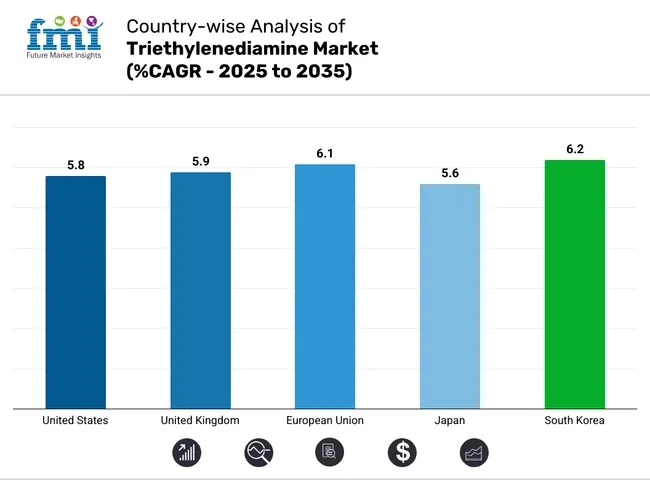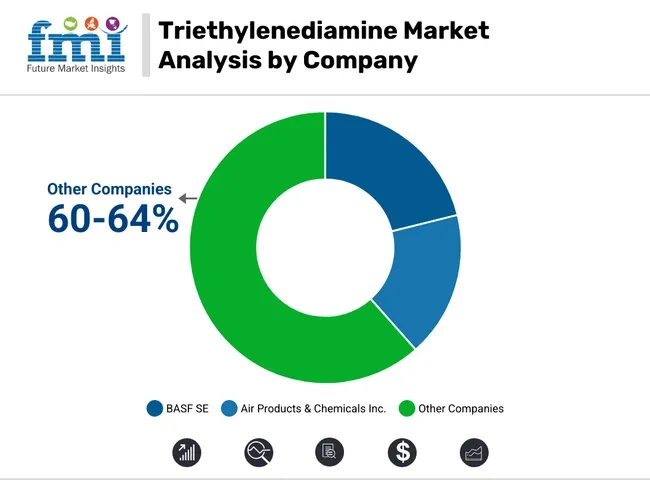The Triethylenediamine market is estimated to flourish from USD 212.5 Million in the year 2025 to USD 380.7 Million during the year 2035, at a robust CAGR of 6.0%. Increasing demand for insulation, lightweight automotive parts and increasing end-consumer demand for energy-efficient building materials are supporting the growth of the market. Moreover, growing need for sustainable foam systems has led manufacturers to optimize TEDA usage in low-VOC and eco-friendly formulations.

| Metric | Value |
|---|---|
| Market Size (2025E) | USD 212.5 Million |
| Market Value (2035F) | USD 380.7 Million |
| CAGR (2025 to 2035) | 6.0% |
Triethylenediamine Market, also known as DABCO or TEDA, is expected to grow steadily from 2025 to 2035, due to the increasing use of DABCO in the production of polyurethane foam used in the automotive, construction, and furniture industries. Triethylenediamine is an essential catalyst for rigid and flexible polyurethane foams, sculpting foam's polymerization and structural efficacy.

| By Application | Market Share (2025) |
|---|---|
| Electronics | 36.2% |
Based on their application, electronics is expected to hold the largest share in the triethylenediamine market since polyurethane-based materials are extensively utilized in electronic devices, circuit boards, insulation systems, and protective coatings. Triethylenediamine is a popular polyurethane catalyst, which greatly accelerates the curing rate, structural strength and thermal resistance of the interfacial material, and the three points are very important in electronics manufacturing process.
In the electronics sector, manufacturers are also adopting triethylenediamine to preciously control foaming and gelling reactions in polyurethane. This allows them to create lightweight, stable components with consistent performance at different thermal and mechanical conditions. Its catalytic properties provide uniform density for molded parts as well as smooth surfaces, making it very useful in electronic goods mass production.
As consumer electronics shrink, lighten and gain complexity, there is growing demand for advanced materials that deliver insulation, shock resistance and fire retardancy demands that triethylenediamine-catalyzed polyurethanes meet very effectively. Moreover, the increasing usage of these polyurethane components in wearable electronics and IoT devices is expected to open new paths as well, contributing to the high demand for this catalyst.
Owing to the strong electronics manufacturing base in this region, Asia-Pacific counts as one of the chief markets for triethylenediamine consumed in electronics. Due to increasing demand for specialty foams and coatings in electronic assemblies, global players are leveraging the region for development of enhanced R&D and supply chain efforts. Rapid technological advancements will ensure that the electronics industry remains a key driver of triethylenediamine market growth.

| By Product Type | Market Share (2025) |
|---|---|
| Rigid Foam | 41.8% |
Among product types, rigid foam is the leading product type in the triethylenediamine market due to widespread application of triethylenediamine based rigid foam in application that require high dimensional stability, insulation properties, and compressive strength. Triethylenediamine is a very effective catalyst for rigid polyurethane foam formulations, decreasing reaction times and providing uniform foam expansion and cure profiles.
Industries such as construction, refrigeration and electronics use rigid polyurethane foams for manufacturing insulation panels, structural cores and energy-efficient housing solutions. In all of the above applications, triethylenediamine improves performance through tight cells and uniform thermal conductivity. These attributes enable producers to supply materials that comply with the ever-tightening energy efficiency and fire resistance regulations.
Automotive and appliances sectors are also extensively using rigid foam for soundproofing and thermal insulation application. The use of Triethylenediamine provides a mechanism for tuning foam density, which allows for optimization for the specific need without degrading mechanical properties. This is particularly important in two-component foam systems that are used in automated production lines and that can initiate both the blowing and the gelation reactions.
As the number of green building certifications and sustainable building initiatives increase, so does demand for energy-efficient products like rigid foam. Polyurethane formulations that are recyclable and low-emission are also being developed by manufacturers, and triethylenediamine is still relevant in these applications due to its consistent performance and catalytic control. Hence, the rigid foam segment is likely to continue to dominate the product type segment throughout the forecast period.
Environmental and Health Concerns
TEDA itself is a very efficient compound but is toxic, and breathing it in can have an impact on health, and therefore there are toxicological and environmental concerns about the volatility of TEDA in an environment. Existing regulations in the USA and Europe are also tightening their grip on the use of such chemicals, with countries mandating manufacturers to reduce TEDA levels or find safer catalyst alternatives. This has driven R&D investment in low-toxicity polyurethane catalysts and reformulated foam systems.
One means of overcoming this challenge would be the increase in investment into encapsulated catalyst technologies from market players, coupled with the increased investment into zero emission hybrid systems from the market that strike a balance between reduction and regulatory compliance.
Expanding Use in Energy-Efficient Construction
As the global consciousness regarding climate change and energy-saving grows, the uptake of polyurethane foams-catalysed by TEDA-for thermal insulation applications is increasing. TEDA facilitates the quick and consistent formation of foam, which is especially important in wall insulation, roofing, and HVAC duct systems.
TEDA offers high-efficiency catalytic activity in rigid foam constructs and capitalizes on growing trends in the construction of zero-energy buildings (ZEBs) and demand for green-certified construction materials. Companies that develop eco-friendly catalyst processes while maintaining performance will be at a competitive advantage.

Growing demand for triethylenediaminein the United States The triethylenediamine market in the United States is anticipated to grow at a CAGR of 5.8% from 2025 to 2035. Increasing use of polyurethane as a waterproofing compound in automotive, construction and consumer applications will generate numerous opportunities across this region.
Triethylenediamine is an important catalyst used in foam manufacturing processes such as the production of flexible and rigid foams. Insulations in buildings also keep rising in the USA bringing back the housing projects and infrastructure works, driving the consumption of polyurethane and consequently, triethylenediamine demand subsequently.
| Country | CAGR (2025 to 2035) |
|---|---|
| United States | 5.8% |
The UK triethylenediamine market is estimated to witness a significant growth 5.9% CAGR during the forecast period, i.e., 2025 to 2035. As energy efficiency laws and green building requirements become stricter, so does the need for high-performance insulation products, and especially for polyurethane foams.
As a catalyst in these applications, triethylenediamine benefits from the increasing focus on lowering energy use and carbon dioxide emissions. The growth of cold chain logistics and the packaging industry regionally also further fuels the growth of this market.
| Country | CAGR (2025 to 2035) |
|---|---|
| United Kingdom | 5.9% |
The triethylenediamine market in the European Union is expected to grow at the highest CAGR of 6.1% during the forecast period. EU countries are intently pushing for thermal efficiency in residential and commercial structures, resulting in increased demand for polyurethane-based insulation solutions.
Triethylenediamine acts as a significant accelerator in the foam formation process, which is why it becomes essential in this background. Furthermore, in the automotive sector, countries such as Germany, France, and Italy is still incorporating advanced foaming materials for weight reduction and performance, which would help retain the chemical's regional influence.
| Region | CAGR (2025 to 2035) |
|---|---|
| European Union | 6.1% |
In Japan, triethylenediamine market is expected to grow at a CAGR of 5.6% over the forecast period. Demand is bolstered by the nation’s robust automotive and electronics industries. Triethylenediamine is commonly used in polyurethane foams in car seats and dashboards and in thermal insulation panels.
Japan's initiative toward environmentally friendly materials and resource-saving technologies shuns the use of methods that use inefficient chemical catalysts; efficient methods like using triethylenediamine remain the preference, especially in precision manufacturing applications.
| Country | CAGR (2025 to 2035) |
|---|---|
| Japan | 5.6% |
The South Korean triethylenediamine market is anticipated to expand at a CAGR of 6.2% during the forecast period (2025 to 2035). Polyurethane foams are major end-use product for the country’s ascending electronics, and appliance and automotive sectors.
Furthermore, demand for insulation products continues to be reinforced by urban development and government-sponsored smart infrastructure projects. In foam production, triethylenediamine is one of the key enablers and benefits from South Korea’s strong manufacturing capabilities and rising export activity across Asia-Pacific markets.
| Country | CAGR (2025 to 2035) |
|---|---|
| South Korea | 6.2% |
Increasing demand for polyurethanes from the automotive, furniture, and construction industries is driving the growth of the Triethylenediamine Market. With increasing demand worldwide, they emphasize production capacity expansion, supply chain efficiency, and sustainable catalyst development. Asia Pacific continues to be an amalgam of a major production hub owing to better access of the raw materials along with the lower manufacturing cost.

BASF SE (20-22%)
The catalyst approach from the company particularly at high-performance catalysts for polyurethane manufacturing has allowed them to control the triethylenediamine sector. At the core of the company is sustainability, reliability, and supply chain agility, particularly in the Asia Pacific markets.
Air Products & Chemicals Inc. (16-18%)
Our industry-leading polyurethane catalysts enhance foam quality while lowering emissions and are supported by numerous global facilities, knowledgeable experts, and reliable service related to polyurethane catalysts. In 2025, it launched green catalyst systems for the bedding and automotive sectors.
Eastman Chemical Company
Eastman ensures reliable global supply through robust logistics and distribution networks. The firm concentrates on R&D to deliver catalysts that support longer foam lifespans and reduced VOC emissions.
Jiangxi Donggxu Chemical Co. Ltd.
Jiangxi Donggxu expanded output to meet increasing domestic and international demand. The company targets rigid foam manufacturers with cost-effective and high-purity offerings.
Tianjin ZhongxinChemtech Co. Ltd.
Tianjin Zhongxin diversified its client base across Europe and Asia and now offers advanced catalyst formulations designed for consistency in foam production environments.
Shanghai GAOXIANG Chemical Co. Ltd.
Shanghai GAOXIANG capitalizes on flexible packaging and insulation applications. The company ensures competitive pricing and tailored catalyst grades for specific foam uses.
The overall market size for the Triethylenediamine Market was USD 212.5 Million in 2025.
The Triethylenediamine Market is expected to reach USD 380.7 Million in 2035.
The demand is driven by the escalating need for polyurethane products, particularly in the automotive and construction sectors, where triethylenediamine serves as a critical catalyst in foam production.
The top 5 countries driving market growth are the USA, UK, Europe, Japan and South Korea.
The Electronics segment is expected to command a significant share over the assessment period.






Full Research Suite comprises of:
Market outlook & trends analysis
Interviews & case studies
Strategic recommendations
Vendor profiles & capabilities analysis
5-year forecasts
8 regions and 60+ country-level data splits
Market segment data splits
12 months of continuous data updates
DELIVERED AS:
PDF EXCEL ONLINE

Thank you!
You will receive an email from our Business Development Manager. Please be sure to check your SPAM/JUNK folder too.
Chat With
MaRIA